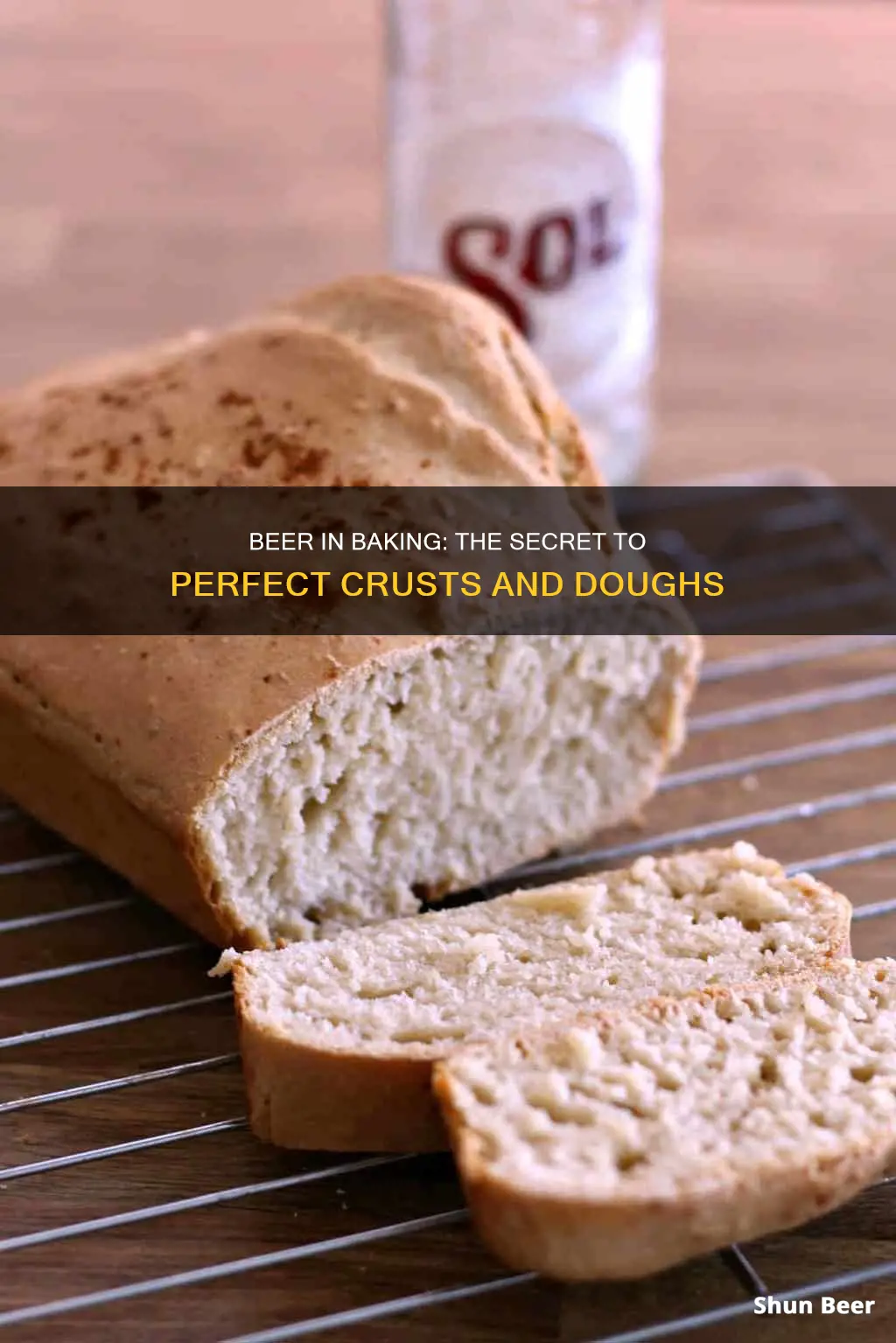
Beer is an underutilised baking ingredient that can add a unique twist to your cakes, breads and cookies. The carbonation in beer helps with leavening, giving baked goods an extra lift and a fluffy, tender texture. Beer also adds a complex depth of flavour to sweets and savoury breads. With so many varieties of beer available, from stouts to IPAs, the possibilities for beer-infused bakes are endless. Whether you're making a chocolate cake, brownies or even candied bacon, beer can be the secret ingredient that takes your bakes to the next level. So, if you're looking to add a little extra fizz to your baking, why not give beer a go?
| Characteristics | Values |
|---|---|
| Beer as a leavening agent | Beer's carbonation assists with leavening and gives extra lift to baked goods. |
| Beer's effect on texture | Beer gives a tender texture to breads and cakes. |
| Beer's flavor range | Beer has a wider range of flavor profiles than spirits, including citrus, coriander, pepper, vanilla, and caramel. |
| Beer's versatility | Different types of beer can be used in various recipes, from cookies and cakes to stews and marinades. |
| Beer's role in flavor enhancement | Beer enhances the flavors of other ingredients, such as chocolate in desserts or spices in savory dishes. |
| Beer's impact on fermentation | When used in bread, beer imparts a slightly fermented flavor. |
| Beer's effect on meat | Beer helps tenderize meat and adds an earthy, smoky flavor to barbecue sauce. |
What You'll Learn

Beer's carbonation assists with leavening, giving extra lift to breads and cakes
When used as the liquid in a recipe, beer's carbonation assists with leavening and gives baked goods an extra lift and a tender texture. The bubbles in the beer help lift the dough and impart a malty, slightly fermented flavour to the loaf. This makes for a recipe your guests won't soon forget.
Beer's carbonation can also create a crisp, tasty crust. The high carbonation in lager, for example, creates a crisp texture, and the relatively mild flavour of the beer does not overpower the food. This makes lager an excellent choice for fried foods.
When baking with beer, it's important to use freshly opened, room-temperature beer. Pour it out and let it sit for about five minutes before adding it to your recipe. This allows the foam to dissipate and releases some of the carbonation.
Beer's carbonation can also be used to add lift and texture to cakes. Paler brews like lager and Witbiers with citrus and coriander notes can add a unique twist to cakes with similar flavours. For example, pairing a blood orange Witbier cake with a bold citrus cake can result in a surprisingly delicious combination.
The Magic of Bottoms-Up Draft Beer: How Does It Work?
You may want to see also

Beer's bitterness balances the richness of creamy foods
Beers Bitterness Balances the Richness of Creamy Foods
Beer is an underutilised baking ingredient. It can have a wide range of flavour profiles, from citrus and coriander to pepper, vanilla, and caramel. Beer's carbonation assists with leavening in baked goods, giving extra lift and a tender texture to breads and cakes.
The hops used in brewing beer make it bitter, but the malt in beer provides natural sweetness to balance the flavour. This bitterness also helps to balance rich and creamy foods. For example, a cheese fondue, or a French onion soup.
When baking with beer, porters and stouts are a good place to start. They are brewed with dark roasted malt, which lends flavour notes of cocoa and coffee. Porters lean more towards chocolate and malted flavours with less bitterness, while stouts offer a more intense bitter coffee flavour and are often higher in alcohol.
Amber and brown ales also work well in baking. Their low bitterness and nutty flavour with hints of caramel complement cookies, pies, and sweet sauces.
When using beer in baking, it is important to use freshly opened, room-temperature beer. This is because beer is best paired with full-fat dairy—its acidity can curdle lower-fat ingredients. It is also best to bake and serve beer-based desserts on the same day, as the flavour of the beer can change over time.
The Magic Behind Draft Beer: Bar System Explained
You may want to see also

Beer tenderises meat, like a wine marinade
When cooking with beer, it is important to choose the right type of beer for your recipe. Wheat beers go well with chicken and seafood, while ales, porters, and stouts are perfect for pork, beef, and lamb. If you're looking for a versatile option, pale ale is a good choice as it has a nice balance of hoppiness, richness, and fruitiness without being too overpowering. However, it's best to avoid IPAs as they tend to be too bitter.
When substituting beer for wine in a recipe, lighter ales can replace white wine, and wheat beers are especially good for this. Dark ales, porters, and stouts can stand in for rich, robust red wines. The key is to match the intensity and weight of the beer to the flavour of the dish. For example, a robust meat like beef or lamb pairs well with a full-bodied brew like a stout or porter.
Beer Buddy: How It Works and Why It's Awesome
You may want to see also

Beer's carbonation creates a crisp, tasty crust in fried foods
When it comes to frying foods, carbonation is key to achieving that coveted crisp texture. This is where beer comes in. The high carbonation in lager, for instance, creates a tasty crust on fried foods, without overpowering the flavour of the food itself.
Carbonation refers to the carbon dioxide gas in a liquid. In the case of beer, this gas is sealed in a container under pressure, which is then released when the bottle or can is opened, resulting in the formation of bubbles. This carbonation process is what gives beer its distinct fizziness and refreshing quality.
When it comes to cooking with beer, the options are endless. Beer can be used in a variety of dishes, from savoury to sweet, and can even be used as a marinade or in a batter. The key is to choose a beer that you would enjoy drinking, as the flavour will be imparted to the dish. However, it's important to note that not all beers are created equal when it comes to cooking. While a light lager can be used for fried foods, a stout might turn the batter an unappetising grey. Additionally, the bitterness of certain beers, such as IPAs, can be too intense for some dishes.
So, the next time you're looking to elevate your fried foods, consider reaching for a beer. The carbonation will create a crisp, tasty crust that's hard to beat. Just remember to choose your beer wisely and always cook with a beer that you would happily sip on its own.
Does Helium-Infused Beer Really Work?
You may want to see also

Beer's malty, fermented flavour enhances bread
Beer is an underutilised baking ingredient, with a wide range of flavour profiles that can be used to enhance baked goods. Beers contain malt, which provides a natural sweetness that balances the bitterness of hops. This malted, slightly fermented flavour can be imparted to bread, creating a unique and memorable recipe.
The carbonation in beer also assists with leavening, helping to lift and lighten the dough. When used as the liquid in a bread recipe, beer gives an extra lift and a tender texture to the loaf. The bubbles in the beer help to aerate the dough, resulting in a lighter and airier final product.
Different types of beer will impart distinct flavours to the bread. For example, porters and stouts are brewed with dark roasted malt, lending flavour notes of cocoa and coffee. Porters tend to have a stronger malted flavour with less bitterness, while stouts offer a more intense bitter coffee flavour and often have a higher alcohol content. These beers pair well with chocolate, making them an excellent choice for chocolate bread or cake recipes.
Amber and brown ales, on the other hand, have low bitterness and nutty flavours with hints of caramel. They work well in cookies, pies, and sweet sauces. The complex notes of amber ale can enhance the flavour of spices and raisins in ginger molasses cookies, for example.
Lighter brews such as lagers and Witbiers have citrus and coriander notes that can complement cakes with similar flavours. They can also be used in place of wine when steaming mussels or making a light and crispy beer batter for fried foods.
When baking with beer, it is important to use freshly opened, room-temperature beer. Allow the beer to sit for a few minutes before adding it to the recipe to let the foam dissipate and release some of the carbonation. Additionally, beer works better with full-fat dairy as it is acidic and can curdle lower-fat ingredients.
The Great American Beer Festival: What's on Tap?
You may want to see also
Frequently asked questions
Beer is a versatile ingredient that can be used in both sweet and savoury dishes. It can add a deep, earthy flavour to savoury dishes and a nutty, caramelised flavour to baked goods. Beer also has carbonation, which helps with leavening and gives baked goods an extra lift and tender texture.
Porters and stouts are a good place to start as they lend flavour notes of cocoa and coffee. For a less bitter option, porters lean towards chocolate and malted flavours. Amber and brown ales also work well in baking and have a nutty flavour with hints of caramel, making them a good choice for cookies, pies and sweet sauces.
Don't cook with a beer that you wouldn't want to drink. Choose a beer that complements the flavour of the dish. For example, wheat beers go well with chicken and seafood, while stouts pair nicely with chocolate.
Yes, beer can be used in place of other liquids in a recipe. However, it is important to note that beer is acidic and can curdle lower-fat ingredients, so it is best paired with full-fat dairy.
Beer does not have a high alcohol content to begin with, and any alcohol present will quickly evaporate during the baking process. Therefore, you don't have to worry about serving baked goods made with beer to children.







